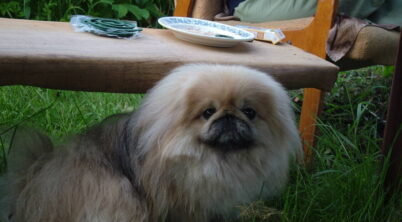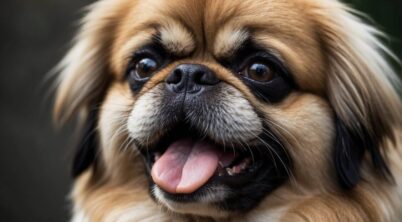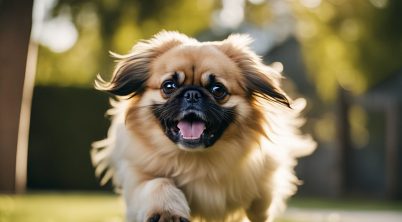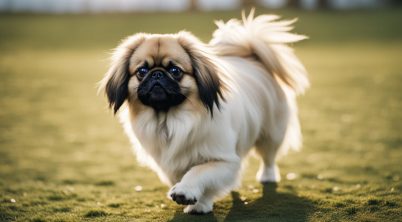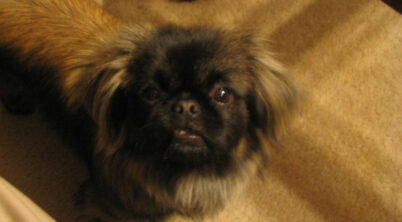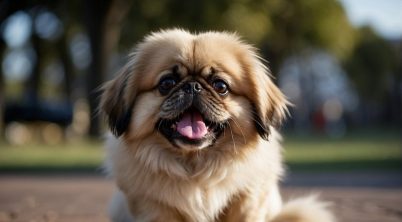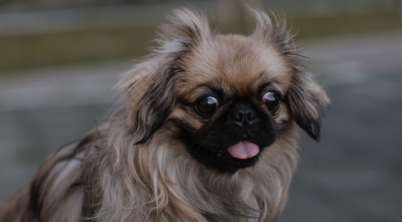Pekingese, a toy dog breed of regal bearing and distinctive characteristics, originated in China and has a history intertwined with Chinese nobility. Characterized by their lion-like mane and a compact, sturdy body, they exhibit a confident and independent demeanor that has captured the hearts of dog enthusiasts worldwide. Their calm and quiet disposition makes them excellent indoor companions, often content with the amount of exercise an indoor environment provides. They are known for being polite with strangers and typically accepting of other animals, making them adaptable to various household settings.
This breed’s physical attributes, such as the shortened snout and large eyes, accentuate its unique appearance. However, these features also relate to specific health considerations; the flat-nosed nature of the Pekingese can lead to breathing issues, a factor reputable breeders are aware of and mitigate through selective breeding. Despite their exercise needs being relatively low, it is crucial to maintain a balanced diet to prevent obesity, as they are prone to weight gain.
The Pekingese’s long, luxurious coat, which helped them endure the cold climates of ancient China, requires regular grooming. While they do not require long walks, they need a suitable environment to minimize exposure to extreme heat or humidity due to their facial structure. With proper care, Pekingese dogs can be well-mannered and affectionate pets, fitting for both experienced and first-time dog owners who seek a small, less active companion.
Is Pekingese a Good Breed?
The Pekingese is a dog breed with a regal demeanor and a distinctive personality. Known for its independence and confidence, this toy breed does not require extensive exercise, making it well-suited for indoor living. They are often polite with strangers and coexist with other animals, making them amenable companions in a variety of household settings.
Characteristics of the Pekingese include:
- Size: Small, considered a toy breed
- Temperament: Independent, calm, and confident
- Exercise Needs: Low; short daily walks suffice
- Good with Other Pets: Usually accepting of other animals
Health Considerations:
- Breathing: Potential for respiratory issues due to their flat faces
- Heat Sensitivity: Prone to overheating in hot or humid weather
- Feeding: Minimal food requirements; prone to obesity if overindulged with treats
Grooming Needs:
- Coat: Long, requiring regular grooming
- Grooming Frequency: Daily brushing recommended to avoid matting
Ideal Living Conditions:
- Indoors/Outdoors: Best kept mostly indoors
- Activity Level: Does well with indoor play and short outdoor activities
The Pekingese may be a good breed for someone seeking a small, low-maintenance companion animal that does not need a lot of physical activity. They might fit well in an apartment or a home without a large yard. Due to their breathing issues, one should consider the Pekingese’s health needs and sensitivity to temperature. When selecting a Pekingese, it’s important to work with a reputable breeder who takes health concerns into account.
Physical Characteristics
The Pekingese breed exhibits a distinct and regal appearance, characterized by a combination of a sturdy, compact body and a luxurious double coat. Understanding these features is crucial in recognizing the breed’s standard look and grooming requirements.
Breed Standard
The Pekingese is known for its stocky, muscular body and lion-like appearance. The breed standard specifies a dog with a broad chest, heavy front, and a typically confident, slightly rolling gait. They have a wide, flat skull, and the face is characterized by a short, broad snout and large, round eyes that contribute to their expressive demeanor.
Size and Weight
- Height: 6-9 inches tall at the shoulders
- Weight: up to 14 pounds
Pekingese are small dogs with a notably heavy bone structure for their size, giving them a sturdy, substantial presence.
Coat and Colors
The coat of a Pekingese is long, course, and double-coated, which requires regular grooming to maintain its condition and appearance. The outer coat is long, while the undercoat is softer and provides insulation.
Colors:
- Solid: Black, cream, red, sable, white, gray
- Parti-color: Combinations that include any of the above
They may also have a distinct black mask, and some Pekingese will exhibit a combination of colors. These colors contribute to their dignified and striking appearance.
Temperament and Personality
The Pekingese is a breed with a complex personality, combining a regal dignity and confident nature, often showing independence and a certain level of intelligent stubbornness. They are affectionate with their families while maintaining a sense of aloofness that speaks to their ancient, noble origins.
Behavioral Traits
The Pekingese displays a unique set of behavioral traits, marked by a strong-willed and confident character. Though loyal and devoted, they can often be stubborn, with an intelligence that requires patient and consistent training methods. Their regal and dignified nature is sometimes perceived as aloofness, but is merely a facet of their complex personality.
- Intelligence: They are quite intelligent, which can lead to stubbornness as they may prefer their own decisions over commands.
- Independence: The breed is known for its independent streak, which means they are not as demanding of attention as other breeds might be.
- Loyalty: Despite their independent nature, Pekingese are extremely loyal to their owners.
- Companionship: They cherish companionship, though on their own terms, and can be quite charming when they choose to engage.
Compatibility with Families
When considering a Pekingese as a family pet, it’s important to understand their interactions with family members, especially children.
- For families: They are affectionate and can fit well within the family dynamic, provided they are treated with respect.
- With children: Because of their small size and self-important demeanor, they may not be suitable for families with very young children who may handle them roughly.
- Family companionship: Offering staunch companionship, a Pekingese can be a loving addition to the home, valuing the bond with their family unit.
Note: Early socialization and clear boundaries are crucial in fostering a harmonious relationship between the Pekingese and family members.
Health and Care
The Pekingese breed, known for its distinctive physical characteristics and regal bearing, requires dedicated attention to its health and care. This section explores the common health issues, grooming necessities, and exercise and nutrition guidelines to maintain the breed’s well-being.
Common Health Issues
Pekingese dogs, a brachycephalic breed, are prone to certain health concerns due to their short face and domed head. Such anatomical features can lead to breathing difficulties and snoring. They are also susceptible to eye diseases, joint disorders, and skin conditions. Regular health check-ups with a veterinarian can help manage these issues and contribute to a longer lifespan.
Grooming Requirements
Grooming is an essential aspect of Pekingese care, as their long, luxurious coat demands regular maintenance. They require:
- Daily brushing: To prevent tangles and matting.
- Weekly baths: To keep their coat clean.
- Less frequent grooming essentials include ear cleaning and nail trimming. It is important to note that Pekingese are heavy shedders, so routine grooming not only contributes to their health but also helps manage shedding in the home.
Exercise and Nutrition
Despite their small size, Pekingese should participate in at least 30 minutes of exercise daily. This can include short walks and play sessions to maintain a healthy weight and lifestyle. Overfeeding should be avoided, as it can exacerbate health problems associated with their structure.
For nutrition:
- The breed requires a balanced diet.
- Feeding high-quality commercial kibble or wet food approved by the Association of American Feed Control Officials (AAFCO) ensures they receive the necessary nutrients.
Adapting exercise requirements and nutritional intake to the individual dog’s needs is crucial, taking into account their age, size, and health status to support optimum health.
Training and Socialization
Training a Pekingese requires understanding their temperament and employing effective strategies. Socialization is crucial for this breed to develop into well-adjusted pets.
Effective Training Techniques
The Pekingese is an intelligent breed with a streak of independence, which can sometimes be mistaken for stubbornness. Successful training techniques are grounded in positive reinforcement, rewarding good behavior with treats, praise, or play to motivate them. Consistency is key; trainers should maintain regular training sessions and clear commands to foster obedience.
- Identify motivators: Find what excites the Pekingese, be it food or toys.
- Keep sessions short: Their attention spans are better suited to brief, engaging training.
- Be patient: A Pekingese may take time to learn, so patience is essential.
Social Interaction
Early socialization for the Pekingese helps to combat their natural reserve around strangers and reduces tendencies of possessiveness. They generally get along well with other dogs, especially if introduced at a young age. Introducing a Pekingese to various people, environments, and situations is important:
- Enroll in puppy socialization classes.
- Schedule playdates with other vaccinated dogs.
- Attend dog shows and other pet-friendly events to increase their comfort with crowds and activity.
Socialization also reinforces their capability as excellent watchdogs, as they become more discerning of normal versus unusual behavior in their environment. A Pekingese who is well-socialized is typically less vocal with unnecessary barking. The American Kennel Club (AKC) underscores the value of socializing your Pekingese to harness their alertness in a constructive way. Regular exposure to diverse social scenarios helps mold a Pekingese into a confident and serene companion.

